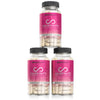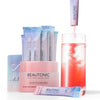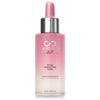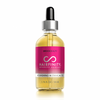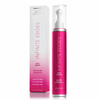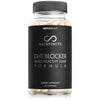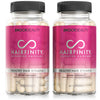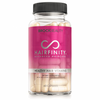
Are Keratin Treatments Bad for You?

Every woman believes that her hair is her finest treasure. The way her hair affects her self-perception is very personal. When she wants to feel like she has the world at her feet, her long, straight hair is all she needs. She doesn't need any fancy jewelry or a special outfit to make her feel like she has the world.
For good reason, many individuals are exploring keratin treatments. If you've ever wanted smoother, frizz-free hair, these products are like a dream come true for many.
They're still a mystery to others because of everything from the possible health hazards to the procedure itself and the final result. As a consequence of the phrase "keratin therapy" covering a wide variety of formulae, application techniques, and outcomes, there is some confusion.
The hair is soaked in formaldehyde solution before being dried and flat ironed in certain "keratin treatments," for example. To help you determine whether a keratin treatment is right for you, read on.
What Is Keratin?
Keratin is a class of structural protein that covers the nails, hairs, the top layer of skin, and even animal feathers as well as horns. To put it another way, keratin serves as a robust, protective layer over the cells that lie underneath it. Keratin is a major factor in protecting hair from frizz, heat damage, and hair breakage.
Fantastic news: We're constantly generating keratin. The continual creation of the protein is due to cells called keratinocytes, which also explains why we lose our hair to make way for new growth.
Keratin production cannot be stimulated by taking a miracle drug or following a strict diet. Thus, it cannot be changed or controlled since it is inherited.
Damaged or depleted keratin proteins in your hair are being broken down quicker than your body can restore them, resulting in excessively porous hair and frizz as a result of over-styling and continual use of heat or chemicals.
We all want to repair this damage, and stylist-recommended keratin treatments are the answer. Let's take a closer look at what it entails.
What is Keratin Treatment?
The keratin treatment is a powerful cosmetic regenerator of the hair cuticle. Actually, our body has keratin, which is a protein that makes it possible to enjoy a beautiful appearance (hair, nails, and skin). But sometimes the body does not produce as much or it decreases over the years.
Depending on the type of treatment—that is, if it has a high level of keratin or a low percentage—the result can be straight hair or hair with soft waves. The final effect or result depends on the product used.
Keratin serves to nourish the hair, repairing the fibers and restructuring it. If you have curly hair, the treatment will stop frizz and make it look manageable.
The truth is that, although it can provide smoother hair, it is not a treatment with this main function, but rather it is a nourishing treatment. In short, the keratin treatment serves to restore the health of your hair.
Benefits
Keratin, the protein that gives hair and nails their natural shine, is synthesized by the human body.
The keratin used in these treatments may be derived from wool, horns, or feathers. Some shampoos and conditioners may contain keratin, but salon treatments are typically the most beneficial.
Professional keratin treatments are more expensive than do-it-yourself options, but there are several advantages to both.
Shiny Hair
Hair strands become more controllable and less frizzy as a result of the smoothing effect of keratin on the cells that make them. A healthy-looking, frizz-free hairstyle can be achieved by using this product.
By temporarily binding the hair back together, keratin can reduce the appearance of split ends.
Long-Term Effects
If you take good care of your keratin treatment, it can last up to six months if you only wash your hair twice or three times per week.
More Manageable Hair
In order to keep your hair in good condition, Keratin treatments are a viable option. This is especially true if your hair is frizzy or thick.
If you frequently use heat to style your hair, you'll notice that your hair dries faster with a keratin treatment. Keratin is said to reduce drying time by as much as half for some people.
Because you can avoid damaging your hair with heat by air-drying it more frequently, you may see an improvement in the health and strength of your hair.
Increased Hair Growth
Hair that has been strengthened with keratin will be less likely to fall out. As a result, hair may seem to grow more quickly since the ends aren't breaking.
Keratin Treatment Side Effects
It is common for patients to report adverse effects following their first wash, which is often 72 hours after treatment. The following are some of the adverse effects that patients have reported to us.
Formaldehyde is used in every well-known keratin treatment. Keratin, a key ingredient in hair treatments, is a carcinogenic chemical. Formaldehyde is utilized in most beauty salons and saloons, and the vapors it produces are harmful. However, there is very little chance of formaldehyde entering the skin since these gases are designed to escape.
As a result, patients are exposed to the cancer-causing potential of formaldehyde without their consent. Hence, there is a substantial likelihood that patients may get cancer. There are just a few items on the market that do not contain formaldehyde, but the required outcomes cannot be attained by using those goods.
Horrific Hair Loss
Keratin treatment might cause some people to lose a lot of hair. In the first week of treatment, even when patients utilize hair products prescribed by salons and parlors, they still feel that they have already lost a significant amount of hair. Because of the rapidity with which hair falls out, patients often express dissatisfaction with their lack of hair after therapy. A dermatologist's checkup is thus recommended prior to any hair treatment, such as keratin.
Worsening Hair Texture
For a while, patients are delighted with the results since their hair seems shiny and full of life. Patients, on the other hand, often report that their hair structure has deteriorated after a few weeks of therapy. Some patients complain that their hair has been damaged, dried out, and faded by the treatment.
A lot of people have also said that their hair is straight after they wash it twice in the evening, but salons and hairdressers have told them that they will soon have curly and wavy hair as well.
Allergic Responses
Keratin treatment might cause allergic reactions in certain individuals. A rash and itching are among the symptoms. Therefore, in order to minimize the risk of an allergic reaction, it is best to talk with a dermatologist or a hairstylist before beginning any treatment. If you've ever experienced an allergic reaction, let us know.
Although keratin hair treatment has numerous advantages, it is important to note that the chemicals in keratin may damage the hair within a few weeks. The application of keratin must be left for at least four days for the product to provide the most benefit to patients.
As a result, individuals undergoing this procedure must switch from their current shampoo or conditioner to the one recommended by the salon. Since typical shampoos may include salt and sulfates, which may break down keratin, leading to dry and frizzy hair, patients need to change their shampoos.
Hairfinity Gentle Cleanse Shampoo is a safe sulfate-free option. Relax with the scent of sea salt, hibiscus, and essential oils as you gently cleanse, and refresh with Harfinity Gentle Hydrating Shampoo that won’t strip hair of it’s natural moisture.
3 Things to Note Before Having a Keratin Treatment!
Even though keratin treatments can cause hair damage on their own, they aren't always bad for your hair. However, you should be aware of a few things before making an appointment for treatment.
1. Safer alternatives do exist
Keratin treatments have been shown to be neither safe nor healthy by several studies. In 2014, the formaldehyde volumes in seven commercial keratin treatments were studied in a research paper. Six of them had formaldehyde levels five times higher than what is deemed acceptable for human consumption. The fact that five out of these six companies claimed to be "formaldehyde-free" is even more startling.
For a long time now, formaldehyde has been known to cause cancer, dating back to 1989.
As a consequence, actual formaldehyde-free keratin treatment options are now available. Consult with your hairstylist about these options to keep yourself safe from exposure to this toxic substance.
2. Treatments aren't the same for everyone
Misconceptions regarding what constitutes a real keratin treatment are widespread. Keratin treatment refers to a wide range of techniques and products.
Don't be afraid to do your research before going to the salon or buying a product. Make sure you know what you're getting into and what you're putting on your hair before going for any keratin treatments.
3. It's not a foolproof method
Even though keratin treatments are promoted as a three-to six-month cure-all for frizz, they may not always perform as effectively as you want. The kind of keratin treatment you get is just as important as your hair type or how well you care for your hair in the immediate aftermath of your treatment. A lot of things might go wrong, and it could take 3 to 6 months before things start to get back to normal.
Alternatives
If formaldehyde exposure is a concern for you, there are alternatives to keratin treatments that may provide comparable results.
It is possible to smooth your hair using heat stylings, such as using a blow dryer or flat iron.
Moisturizing your body is another way to keep it robust and healthy (especially if you like to use heat-styling tools).
Soap may strip your hair of its natural oils, so wash your hair only when necessary. You might also attempt the "no-poo" approach.
You may also use products that include natural moisturizers, such as:
- Coconut oil
- Argan oil
- Shea oil
- Sunflower butter
- Olive oil
How Should I Take Care of My Hair After Every Keratin Treatment?
To extend the life of your keratin treatment, follow these instructions:
Hair might lose part of its protein treatment due to water and dampness. This may cause the hair to become brittle and prone to frizz, but it can also leave behind markings in the hair that are difficult to remove. Don't shower or perform any strenuous physical activity for at least 3 days following the treatment, since you don't want to sweat.
- For the first few days following your treatment, try to keep your hair as straight and down as possible. Putting hair in a ponytail or knot or braiding it might leave behind dents since such keratin is pliable at first. Hair ties may be used after three days. Don't wear your hair in a bun for too long.
- Silk pillows and pillowcases are preferable for your keratin treatment because cotton and other materials may cause friction while you sleep, resulting in frizz and reducing the life of your treatment.
- The best shampoos and conditioners for hair are those that do not contain sodium lauryl sulfate (SLS) or sodium Laureth sulfate (SLS). Using these detergents can cause your treatment to burn out sooner than planned since they deplete the hair of its natural oils and keratin. HAIRFINITY offers a range of sulfate-free shampoos and conditioners for all hair types.
- Keratin hair treatments necessitate the use of blow dryers and flat irons to keep hair smooth and straight. It is unnecessary to use hair styling products such as hair sprays or gels, root-lifting treatments, etc. since the weight of the keratin treatment will keep your hair in the proper position.
- Reapply the keratin treatment every three to five months, or whenever it starts to wear off.
Final Thoughts
Although keratin hair treatments may give you silkier, more lustrous hair, they often include formaldehyde, which can have several negative side effects.
Even though some manufacturers say their products are formaldehyde-free, many of them still have some of the chemicals in them.
Although the long-term effects of a single keratin treatment are yet unknown, if you're prone to allergies or asthma, you should avoid it.
Pregnant or nursing women should also avoid keratin treatments.
















